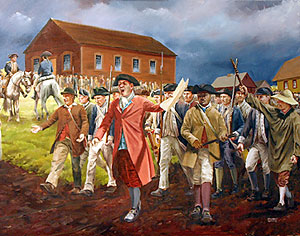
The Articles of Confederation were created by the United States in an act to form a written constitution in 1777. Ratified in 1781, the Articles seemed a little too centralized and overpowering for the States.1 In addition to the Articles, the United States had just ended the Revolutionary War in 1783. Between 1783 and 1786, a number of events took place that led to one of the United States’ most influential rebellions in its history.
After the Revolutionary War ended, it was a very stressful time for the states. These stresses stemmed from a lack of money, resources, and effective government. Each state saw that the government under the Articles of Confederation was not working well in many ways. Many states found themselves with little money, while some saw a corrupt government. In Massachusetts, citizens saw three distinct factors that led to the famous Shays’ Rebellion: a weak national government, a problem involving currency, and the poverty of the citizens of Massachusetts in the aftermath of the war.2 These three factors sum up the problems each state was having. These factors contributed to the aggressiveness of many in Massachusetts. These factors caused the states to become more divided, and it led them to become more independent rather than more united.3 This led to an absence of many states’ involvement in the national Congress, their ability to enforce laws decreased, and most refused to pay for their own delegates’ fees for their participation in Congress when in session.4
When the Articles of Confederation were created, an alliance among the thirteen independent states was established to officially declare the formation of the United States.5 Congress’s power over the States was always limited and weak under those Articles. However, Congress could declare war; but the states simply began not allowing enlistments, limiting Congress’s ability to build an army. Provisions such as these in the Articles of Confederation severely weakened Congress and caused the states to quickly become distant. Some states used different currencies than others, which made it very hard for trade and commerce.6 This difference in currency between States led to many problems in Massachusetts.

As time went on, the calling for rebellion soon reached Massachusetts. One man, Daniel Shays, took it upon himself to speak out against the wrongs of the government, thus initiating the beginning of the rebellion. Daniel Shays was a gold-handed sword award holder for his being Captain in the Revolutionary War. His involvement in the war and in politics created a base from which he could speak out.7 Soon more people joined the revolt and a clear reasoning for the rebellion was laid out. Specific members took it upon themselves to make their views known by speaking out about the problems of the Articles of Confederation and National Government. Resulting in the rebellion beginning in 1786 near the Massachusetts area.
Massachusetts saw state poverty at its lowest, where some farmers even lost their farms due to bad harvests. This brought up the thought of change. The rebellion brought out the debt of the states and the impact of war. The war sent the states into more debt with the cost of war and state governments, and this sent a huge wave of calling for the re-shaping of the Articles of Confederation.8 From this, the rebels soon closed the courts from collection of taxes, and began to shut out commerce from the states.9 This set off a series of debates and reform at the national level. In due time, the reforming would change the future of the United States.10 Its impact on American policy and government still has effects today.
- Jack Rakove, “The Legacy of the Articles of Confederation,” Publius 12, no. 4 (1982): 45. ↵
- Jonathan Smith, “The Depression of 1785 and Daniel Shays’ Rebellion,” The William and Mary Quarterly 5, no. 1 (1948): 78. ↵
- Jonathan Smith, “The Depression of 1785 and Daniel Shays’ Rebellion,” The William and Mary Quarterly 5, no. 1 (1948): 78. ↵
- Jonathan Smith, “The Depression of 1785 and Daniel Shays’ Rebellion,” The William and Mary Quarterly 5, no. 1 (1948): 78. ↵
- Jonathon Smith, “The Depression of 1785 and Daniel Shays’ Rebellion,” The William and Mary Quarterly 5, no. 1 (1948): 79. ↵
- Jonathon Smith, “The Depression of 1785 and Daniel Shays’ Rebellion,” The William and Mary Quarterly 5, no. 1 (1948): 79. ↵
- Sidney Kaplan, “A Negro Veteran in Shays’ Rebellion,” The Journal of Negro History 33, no. 2 (1948): 123. ↵
- Jonathon Smith, “The Depression of 1785 and Daniel Shays’ Rebellion,” The William and Mary Quarterly 5, no. 1 (1948): 80. ↵
- Raymond Starr, The History Teacher 15, no. 3 (1982): 456. ↵
- Robert A Gross, The New England Quarterly 76, no. 1 (2003): 126. ↵



31 comments
Andrew Dominguez
Ive heard of Shays rebellion in previous classes, but this article reminded me of the importance it had in our history. This is an instance in history when people went against the government and actually had a significant change happen. Without this rebellion We still be using the Article of confederation, and we wouldn’t be successful if we hadn’t of changed. This article was great, since it gave insight on our history.
Noah Laing
I briefly studied Shay’s rebellion in high school, however this article definitely went into enough detail and was well descripted, that I have a better understanding of the event and the impact it had on America. Shay’s bold actions helped form a more fair and reasonable central government that still stands to this day.
Brandon Martinez
In previous history classes I briefly learned Shay’s Rebellion and not really ever studied the details. I just thought the rebellion was due to unhappiness within the population, but this article gives other reasons about the cause of it. This rebellion impacted the early government in a major way, and even so that the government made legislation on it. So I think this article is very good and it helps the reader learn about a vital point in the early history of the central government.
Angela Rodriguez
I remember learning about the Shay’s Rebellion. While that feels long ago, it was great to read about Shay’s Rebellion and refresh my mind about what exactly happened during this time period. This article reminds me of the importance speaking up has on unfair treatment. Just as how the Americans spoke out for the incompetent policies. Other than that, great article.
Andrew Rodriguez
Shays Rebellion lead to the new united states as we know today. It seems like we are going through a repeat of this as of recently, with all the division between people and politics. Shay was a key piece to this rebellion cause of his status as a person who fought in the war. He created the platform for change to begin letting it be known that it’s okay to speak out against the current system. To strive for a better one, I feel like this needs to happen again as well, he changed it for the tough times of the past now we must change it for the tough times for the future.
Alexis Soto
I can recall learning of Shay’s Rebellion and that it was an important event in our history as it helped define our country. Now after reading this well written article I was surprised that Shay had been a Captain and how efficient and effective his Rebellion proved to be. I and others would point to this incident as evidence that a strong unified central government was necessary for a stable democracy and security.
Sergio Cervantes
An interesting article to read about the beginning of our country’s history. This in a sense proves that the presence of a federal government is essential to maintaining a country’s stability as we can see from the effects of the Articles of Confederation. Growing up I knew very little about Shay’s Rebellion and its causes. I believe it helped the United States see the fault in the Articles which eventually led to a “new” update.
Johnanthony Hernandez
A well written article, it was more informative than what I learned about it in high school. The detail that it went into helped me understand more about Shay’s Rebellion and what came from it. The impact that he made can still be seen today in the nations policies and the way the government and political situations that we face now.
Cameron Mays
Shays’ Rebellion is heavily discussed throughout school and is something most people have a general grasp on. This means that any article written about said rebellion must differ from the general knowledge at this point, or else it’s just repetitive. I think you should have included something different, such as how this effected the women of the era or something like that. Furthering my point on repetition, this article was quite repetitive, not necessarily with the facts, but in the way it was written. You continually used phrases such as “this led to” and “these factors” which brings the professional aspect of the article down.
Nahim Rancharan
I have never known about Shay’s rebellion until I read this article, but it is easy to see how it shares a common pattern with other rebellions throughout history. It is clear that rebellions are always rooted from the fact that when people are pushed too far, in regard to certain conditions, it is natural for them to rebel at a certain point. In my opinion. Shay’s rebellion was one of the many instances in which Americans have been able to speak out against inadequate government policies and demand change. This rebellion shows that in order to effect change certain measures and sacrifice need to be made. As a result, of this, America was placed in a better position that it was before. This article effectively captures the essence of the human right to speak up against injustices. Great Job!